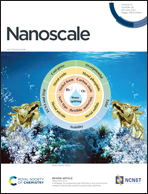Two-dimensional oxide quasicrystal approximants with tunable electronic and magnetic properties†
Abstract
Recently, the discovery of the quasiperiodic order in ultra-thin perovskite films reinvigorated the field of 2-dimensional oxides on metals, and raised the question of the reasons behind the emergence of the quasiperiodic order in these systems. The effect of size-mismatch between the two separate systems has been widely reported as a key factor governing the formation of new oxide structures on metals. Herein, we show that electronic effects can play an important role as well. To this end, the structural, thermodynamic, electronic and magnetic properties of freestanding two-dimensional oxide quasicrystalline approximants and their characteristics when deposited over metallic substrates are systematically investigated to unveil the structure–property relationships within the series. Our thermodynamic approach suggests that the formation of these aperiodic systems is likely for a wide range of compositions. In addition, the magnetic properties and work functions of the thin films can be controlled by tuning their chemical composition. This work provides well-founded general insights into the driving forces behind the emergence of the quasiperiodic order in ternary oxides grown on elemental metals and offers guidelines for the discovery of new oxide quasicrystalline ultra-thin films with interesting physical properties.



 Please wait while we load your content...
Please wait while we load your content...